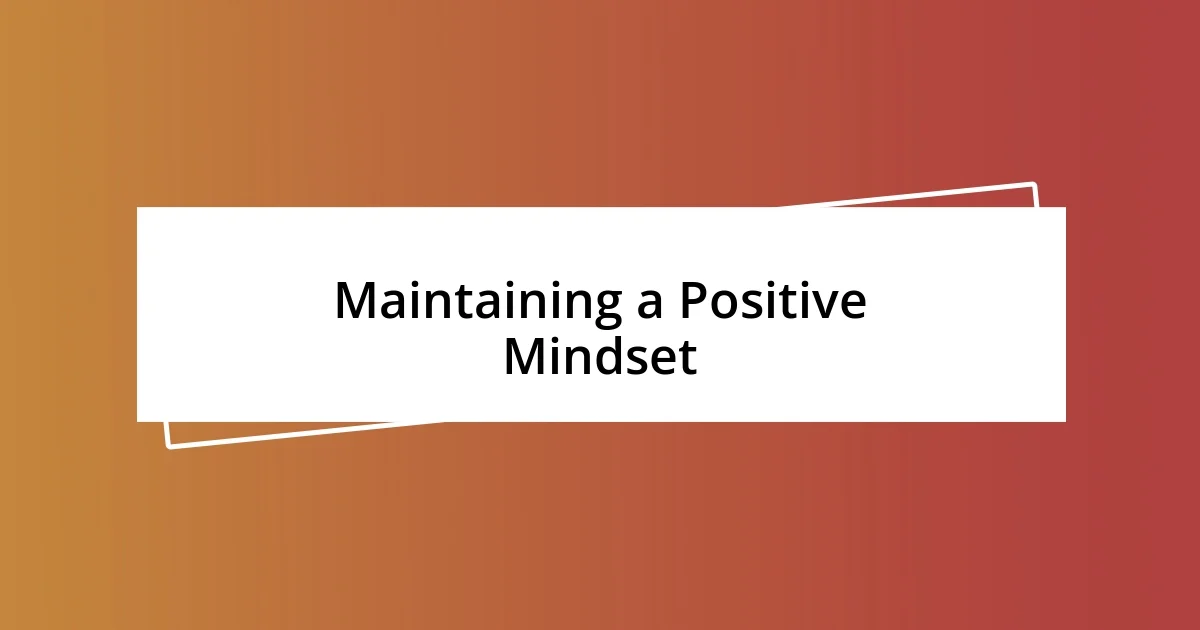Key takeaways:
- Resilience strengthens emotional capabilities, fostering adaptability and valuable life skills that prepare us for future challenges.
- Setting specific, measurable, and adjustable recovery goals enhances motivation and allows for tracking progress in overcoming setbacks.
- Maintaining a positive mindset through gratitude, supportive relationships, and mindfulness techniques significantly aids in resilience and emotional recovery.

Understanding Resilience Benefits
Resilience is like a powerful toolkit that we all carry within us, although at times, it can feel buried deep beneath our challenges. I remember a period in my life when I faced significant setbacks. There were moments when I doubted if I could truly recover, yet tapping into that resilience allowed me to rise and rebuild stronger than before. How many of us have experienced similar situations where, despite the odds, we found a way to keep going?
One of the most profound benefits of resilience is its ability to foster emotional strength. When I faced unexpected difficulties, I discovered that instead of succumbing to despair, I could harness my emotions constructively. Have you ever noticed how your outlook can shift when you face a challenge head-on instead of avoiding it? That shift isn’t just about surviving; it’s about redefining who we are through our experiences.
Furthermore, resilience doesn’t just help us bounce back; it often equips us with valuable life skills. After navigating tough times, I found that I became more adaptable and open to change. This adaptability isn’t just a personal triumph; it radiates into every aspect of life, making it easier to face future hurdles. Isn’t it interesting how with every challenge we tackle, we simultaneously prepare ourselves for what lies ahead?

Identifying Personal Strengths
Identifying personal strengths is a journey of self-discovery that can illuminate pathways to resilience. During challenging times, I often reflect on what drives me forward. It’s a bit like shining a flashlight in a dark room; once you start, you spot qualities you didn’t realize were there. For example, I remember a period when I felt overwhelmed by obligations. By recognizing my organizational skills, I could better manage my time and alleviate stress.
Here are some ways to identify your strengths:
- Self-Reflection: Take a moment to journal about times when you felt proud or accomplished.
- Feedback from Others: Ask friends or family what they believe your strengths are.
- Personality Assessments: Consider taking assessments like the Myers-Briggs Type Indicator to gain insights into your natural tendencies.
- Experience Journaling: Keep a record of moments when you overcame obstacles and what skills you utilized during those times.
Each of these strategies opens up a new perspective on who we are and helps us recognize the innate strengths that can serve as a springboard for bouncing back.

Setting Realistic Recovery Goals
Setting realistic recovery goals can be a game-changer in your journey toward resilience. I’ve found that when I set small, achievable objectives, I feel a sense of accomplishment that fuels my motivation. For instance, after a difficult period, I aimed to take short walks each day. This simple goal not only helped me regain my physical strength but also acted as a mental reset, allowing me to reflect and breathe.
When crafting these goals, it’s essential to ensure they are specific and measurable. I remember setting a vague goal of “feeling better.” It was only when I shifted to “reading one chapter of a book each week” that I began to truly see progress. Have you ever experienced the difference between a broad objective and a targeted one? The clarity can empower you to track your recovery and celebrate your successes along the way.
Lastly, don’t shy away from adjusting your goals as you grow and heal. I’ve learned that flexibility is key. If I set a goal and find I’m struggling with it, tweaking it doesn’t mean I’ve failed; rather, it shows I’m in tune with my needs. For example, if daily movement becomes overwhelming, shifting to a few times a week allows me to maintain balance. Setting realistic recovery goals isn’t just about reaching the finish line; it’s about enjoying the journey, one step at a time.
| Characteristics | Examples |
|---|---|
| Specific | Aim for short walks, or read one chapter a week |
| Measurable | Track completion of goals to recognize progress |

Practicing Mindfulness Techniques
Practicing mindfulness techniques has significantly transformed my ability to bounce back from life’s challenges. I remember a particularly stressful week at work when everything felt like it was piling up on me. I decided to set aside just five minutes each morning to focus on my breath. Simple as it sounds, this brief practice made a world of difference. Have you ever noticed how a few deep breaths can center you amidst chaos?
One mindfulness technique that I often turn to is body scanning. As I lie down, I mentally check in with different parts of my body, releasing any tension I might be holding. The first time I tried this, I was shocked to discover how tight my shoulders were, a reminder of the stress I was internalizing. This practice not only helps relieve physical stress but also fosters a deeper connection to my feelings. What would it feel like for you to fully engage with your body in this way?
Another powerful mindfulness method is gratitude journaling. Every evening, I jot down three things I’m grateful for, and it’s become a habit I cherish. During tough times, this practice helps shift my focus from anxiety to appreciation. I recall one evening after a particularly exhausting day when, instead of ruminating on my stress, I wrote about the smile from a stranger and the warm cup of tea waiting for me at home. It’s simple but effective—what are three things you would write down tonight?

Developing Supportive Relationships
Developing supportive relationships is essential for bouncing back quickly from life’s challenges. I’ve often reflected on how crucial my close friends and family have been during tough times. For instance, when I faced a significant setback at work, it was my best friend who offered not only a listening ear but also practical advice. Have you ever found comfort in someone just being there for you? The simple act of sharing my thoughts made me feel less isolated and more empowered.
In my experience, fostering these supportive connections requires effort and openness. I remember a time when I pushed myself to reach out and engage with my colleagues more. Initially, it felt daunting, but as I shared personal stories during lunch breaks, I noticed deepening bonds. These moments reminded me that vulnerability can strengthen relationships. Have you considered how sharing your own experiences might inspire others to connect with you?
Creating a network of support isn’t just about turning to others in times of need; it’s also about reciprocating that support. I find joy in checking in on friends, offering words of encouragement, or even just sending a quick text to see how they’re doing. This nurturing aspect can lead to a rich tapestry of give-and-take that makes the relationship resilient. What small act of kindness can you offer a friend today? By fostering these connections, we not only uplift others but also create a safety net for ourselves during life’s inevitable ups and downs.

Incorporating Physical Activity
Incorporating physical activity into my routine has been a game changer in how I manage life’s stresses. I recall a particularly challenging period when I made a commitment to walk for at least 30 minutes each day. Initially, it felt like just another task on my to-do list, but with time, those walks turned into my sanctuary. The rhythm of my footsteps and the fresh air worked wonders—have you ever felt the stress just melt away after a good walk?
One of the most profound realizations I’ve had is how physical activity not only boosts my mood but also enhances my resilience. On days when I incorporated a quick workout or a yoga session, I noticed a significant improvement in my mindset. There was this one day when I joined an online dance class just to shake off the heaviness that was weighing on me. The laughter and movement lifted my spirits in a way I hadn’t anticipated. Isn’t it amazing how our bodies can help our minds recover?
In my experience, the key lies in finding an activity that genuinely excites you. For me, it was rediscovering my love for running that reignited my passion for movement. I signed up for a virtual running challenge and found myself not only motivated to stay active but also connecting with a community of like-minded individuals. That’s when I realized—what physical activity could ignite your inner spark? By incorporating movement that resonates with you, bouncing back can feel less like a chore and more like a joyful adventure.

Maintaining a Positive Mindset
Maintaining a positive mindset is often a conscious choice I make. There are days when negativity threatens to take hold, but I’ve found that actively focusing on gratitude can shift my perspective. For example, I keep a journal where I jot down at least three things I’m thankful for each morning. This simple practice reminds me of the good amidst the chaos—have you ever tried reflecting on the positives to lift your spirits?
Another strategy that works wonders for me is surrounding myself with uplifting content. Whether it’s a feel-good podcast, an inspiring book, or motivational quotes, these positive inputs help counterbalance any negative thoughts. I distinctly remember a phase when I immersed myself in self-help audiobooks after facing rejection in my career. Listening to stories of resilience and triumph not only lifted my mood but also fueled my desire to keep going. What’s the last piece of inspiring content that made a difference for you?
I’ve learned the significance of self-talk in keeping my mindset aligned. When negative thoughts creep in, I’ve trained myself to swap them for affirmations—I often say to myself, “I am capable and worthy of success.” Admittedly, it’s been a journey to reshape my inner dialogue, but the results have been empowering. When was the last time you challenged your own thoughts? By actively nurturing a positive mindset, I’ve discovered that I can face challenges head-on, transforming setbacks into stepping stones towards growth.













